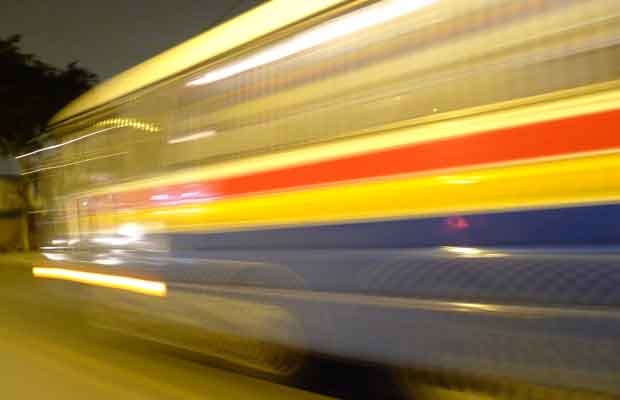Archive for August, 2010
Señal 3 – Community Television in La Victoria, Santiago, Chile
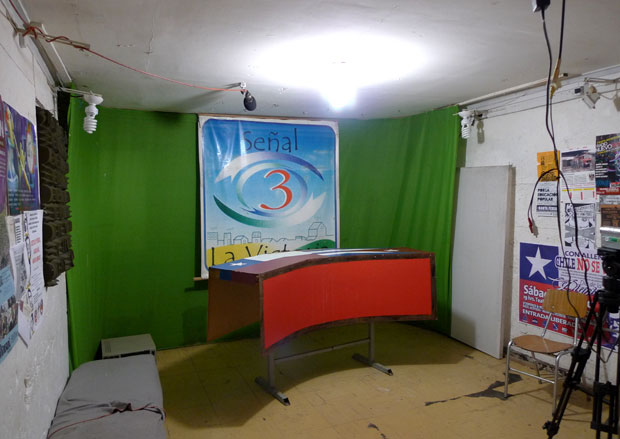
During our stay in Santiago at the end of July to beginning of August, the curator of “portables” and our host, Ignacio Nieto took us to a community television station and media school, Señal 3 (Signal 3). Located in La Victoria, considered amongst the poorest and most dangerous neighborhoods of Santiago, Señal 3 pirates its signal to the immediate area. The government and police do not intervene, because they are afraid to enter the neighborhood.
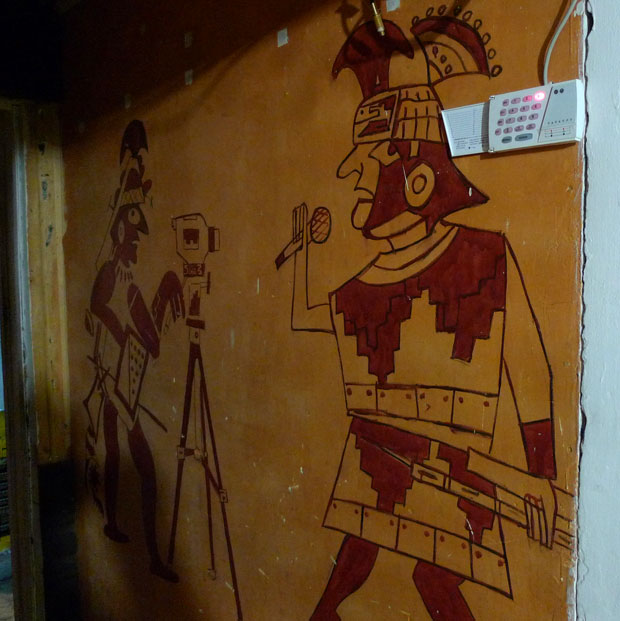
A mural in the hallway leading from the television recording studio to the post-production and broadcast studio.
During the visit, I took the opportunity to interview one of the members who established and helps maintain the community TV station. Learning in detail about the history of Señal 3, seeing their outfit and what they have created as well as their mission is absolutely inspiring. The men who established and run Señal 3 grew up together in La Victoria and were once vigilantes of their neighborhood… ignored by the police and government, it was up to the community to keep the peace. The members of Señal 3 earn a living through video production as they maintain a pirate television station that they’ve transformed into a local media center.
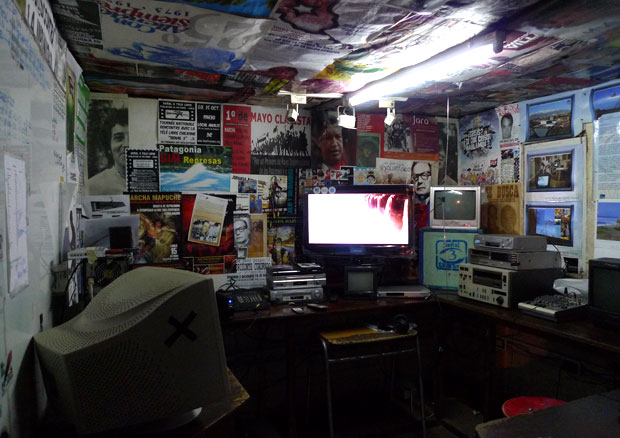
The broadcast studio.
Community media has a long history in La Victoria. In the 70s the neighborhood ran pirate radio, in the 80s the local church was given large televisions that would be stationed on various corners of the neighborhood for major soccer games. Señal 3 with it’s current members has been broadcasting since 1997.
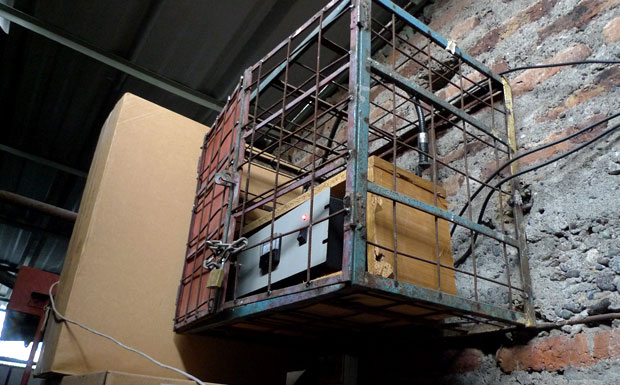
The transmitter in a converted alley way between houses.
The television broadcast was once bounced from member home to member home as necessary. However, several years ago, the home next to one of the members was raided by the police. The owner was selling drugs and pimping girls. He spent time in jail and upon returning to his home the neighborhood would not allow him to remain. The members of Señal 3 made a bid for the drug dealer’s home and then transformed it from a drug den and under age brothel to a community media center… they established a home for their transmitter.
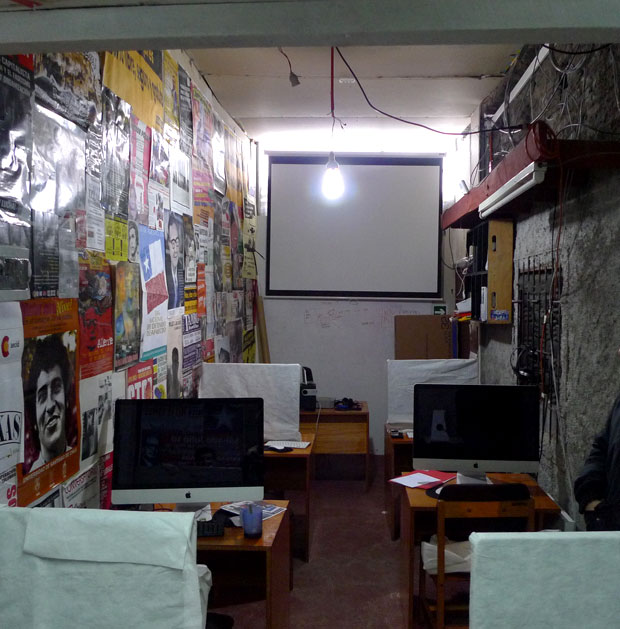
The classroom!
Today the house has a dedicated television studio, a mixing and production studio and media classroom. The members were always dedicated to community television production and working with local kids and neighbors to create programming. However a three years ago, Señal 3 was awarded a major grant by a Spanish institution. They used that grant to establish a proper classroom, equipped with high end iMacs and a projector. Each school year, Señal 3 accepts a handful of kids to run a year long media production course that covers video production – shooting, editing and broadcast as well as computer graphics and web programming. Their intention is simply to make these kids into media producers rather than passive consumers.
Soon they will begin fund raising for the next enterprise, a new building where Señal 3’s current home stands. The new building will offer the community better production facilities, larger classroom… a place where kids in the neighborhood will have access to tools that Chile’s educational system will never make available to those of La Victoria.
A REAL Miracle of Chile – Miners survive collapse
Since returning from Chile a couple weeks ago, I’ve been assembling the project site for Miracle of Chile that questions Milton Friedman’s famous phrase. As part of the project, one may run through a maze that displays Flickr images shot by participants in Chile depicting what they consider to be the Miracle of Chile. Along side of the maze are Twitter entries for Miracle of Chile. It is through these entries that I learned that 33 miners were trapped on August 5th when a mine collapsed. It’s now been 17 days and it is reported that all 33 miners are alive! Uncle Milton, that’s a true miracle!
“Miracle of Chile” Street Documentation
“portables” Video Documentation
Nicolás Spencer N, produced a video documenting the various projects on view as part of the exhibition “portables” curated by Ignacio Nieto for El Museo Nacional de Bellas Artes, Santiago Chile. The video is presented as a component of the exhibition since all of the projects are intended for the public space or for performance.
“portables” Opened Saturday, August 14th
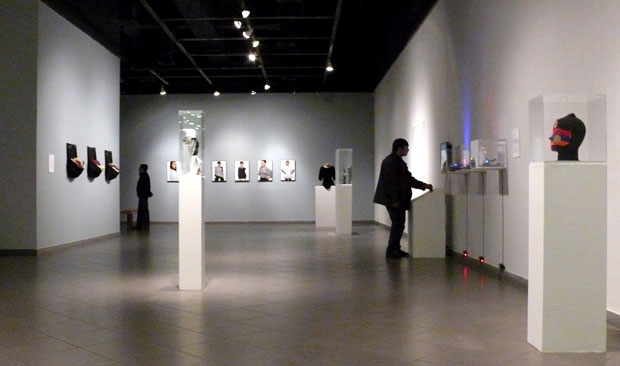
portables, Museo Nacional de Bellas Artes, Mall Plaza Vespucio
I received images from Ignacio Nieto, curator of the exhibition “portables” at the Museo Nacional de Bellas Artes, Mall Plaza Vespucio in Santiago, Chile. The gallery is a satellite gallery of the National Museum and it’s located inside a luxury mall. According to the statistics, this gallery of the Museum is well attended due to its location… Brilliant, if the people will not attend the museum, bring the museum to the people. As mentioned in an earlier post, the exhibition includes Michelle Teran, Chimbalab, Alejandra Perez, Carolina Pino, GraphTech, Otto Von Busch, Ricardo Miranda Zuniga and Kurt Olmstead.
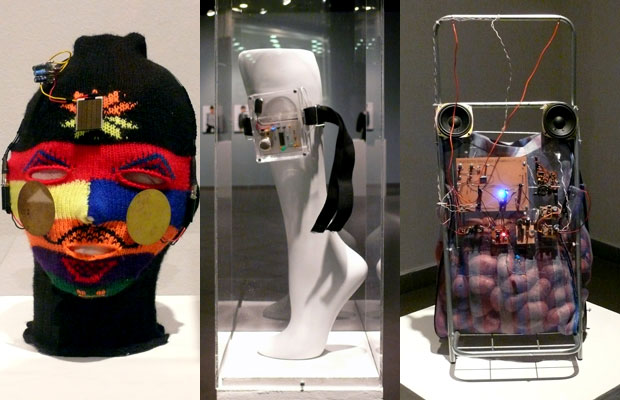
Ignacio selected a group of artists that are using electronics as a creative medium, specifically, creating portable electronics (hand-held or worn on the body). Above are details of works by noise artist, Alejandra Perez who created a sound mask, GraphTech who presented an over the limit alcohol device that calls a phone number in the U.S. when high alcohol levels are detected from a person’s breath and Chimbalab who created a mobile, potato-powered radio station.
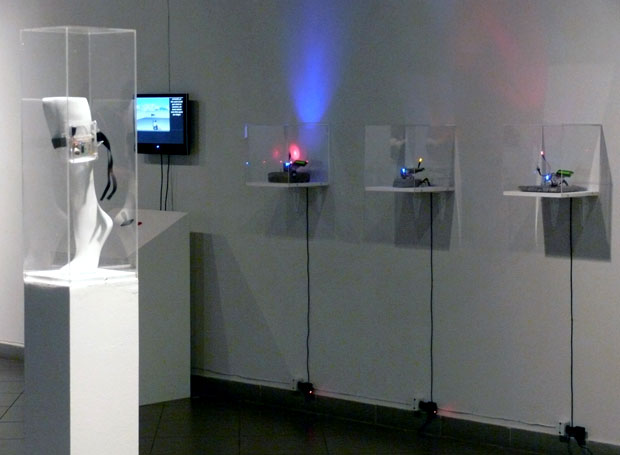
GraphTech, Ricardo Miranda Zuniga and Kurt Olmstead
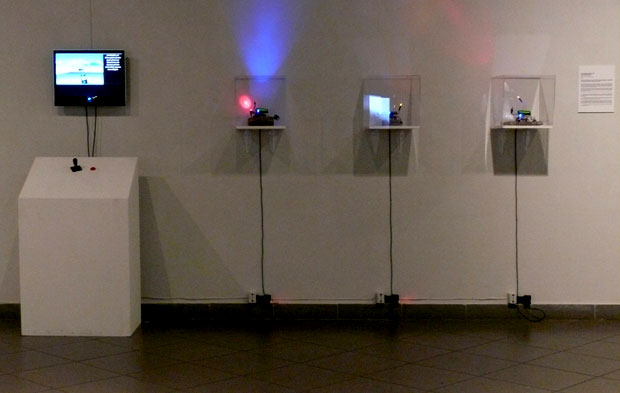
Miracle of Chile
The image above is my collaborative contribution. I worked with my old friend Kurt Olmstead to realize a project specific to Chile – “Miracle of Chile” which I’ve previously posted about. Our portion of the exhibition includes a virtual labyrinth that presents images taken by participants of what the “Miracle of Chile” is to them as reflected on the streets of Santiago, and three circuit boards with LCDs mounted onto tiles of the Santiago sidewalks.
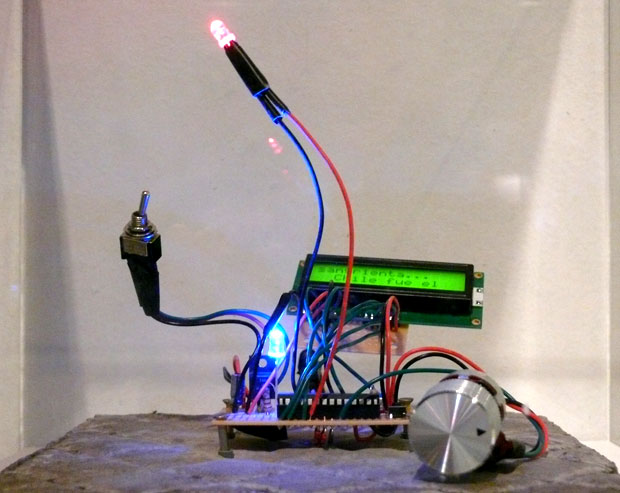
What is the Miracle of Chile?
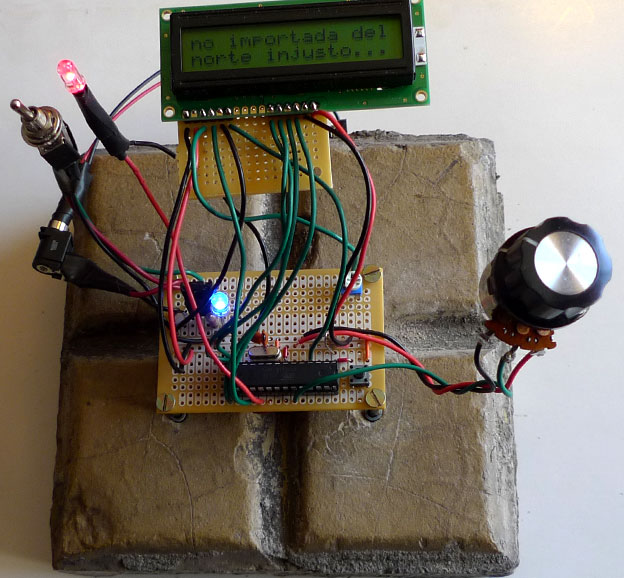
Last November I received an invitation from Ignacio Nieto to participate in an exhibition titled “portables” at the Museum of Fine Arts of Santiago. Last Friday I returned from Santiago, following two weeks of production.
Early this year, I contacted my old friend Kurt Olmstead to work with me on a project that I knew would be beyond the scope of anything that I could do alone within a period of several months. Kurt was on board and we started discussing the premise of the project – Chile as the laboratory for neoliberal economic philosophy of the Milton Friedman flavor. Kurt and I grew up in the midst of Reaganomics. In the 80s, Reagan and Thatcher embraced Friedman’s neoliberalism and Chile was framed as the example of what privatization, deregulation of the markets and cuts to social spending will do to control inflation and allow a nation’s economy to prosper. In 1981, Friedman declared the phrase “Miracle of Chile” to reflect the transformation of Chile’s economy through his neoliberal philosophy as implemented by the Chicago Boys, Chilean economists who studied under Friedman.
It is now 2010, we live in the midst of a global economic crisis and are now questioning the neoliberal economic formula. The art project consists of a workshop, public discussion, bus intervention and a virtual labyrinth. Each element asks participants in Chile to identify the Miracle of Chile in the scope of their city and personal lives. A documentation site is available at www.miracleofchile.com

Two workshops were held as part of the project, one with middle school kids and a second at Matucana100 Cultural Center asked participants to document the Miracle of Chile in their public space.

Street situations, an interactive sidewalk tile invites pedestrians to ask one another “What is the Miracle of Chile?”

As an example of privatization of public space, a small bus intervention was executed on bus rider handles sold for advertisement.
“portables” comienza el 14 de agosto
La apertura para la exposicion portables es el sabado, 14 de agosto a las 18:00 horas en Museo Nacional de Bellas Artes, Mall Plaza Vespucio, Santiago, Chile y permanecera hasta el 19 de septiembre. Curada por Ignacio Nieto, el tema de la exposicion es artistas que usan y crean dispositivos como medio creativo. Portables presenta las obras de Michelle Teran, Chimbalab, Alejandra Perez, Carolina Pino, GraphTech, Otto Von Busch, Ricardo Miranda Zuniga and Kurt Olmstead (fotos abajo).
Yo estoy estrenando El Milagro de Chile, obra colaborativa con Kurt Olsmtead.
“portables” Opens Saturday August 14, Santiago, Chile
The exhibition “portables” opens August 14th at the Museo Nacional de Bellas Artes, Mall Plaza Vespucio and will run through September 19th. The show presents an array of artists using portable electronics as a creative medium and is curated by Ignacio Nieto. The show includes Michelle Teran, Chimbalab, Alejandra Perez, Carolina Pino, GraphTech, Otto Von Busch, Ricardo Miranda Zuniga and Kurt Olmstead.

Chimba Lab takes their portable radio transmission through the market
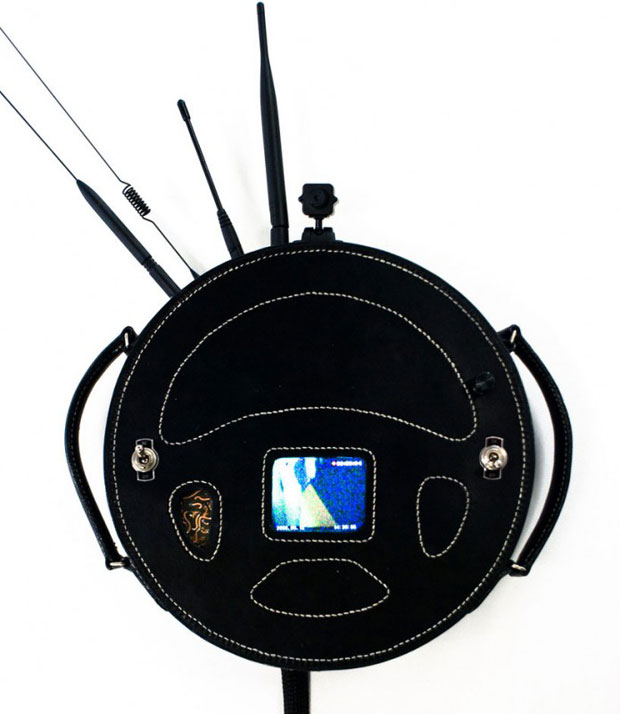
Beautifully encased CCTV viewer – a portable Panopticon
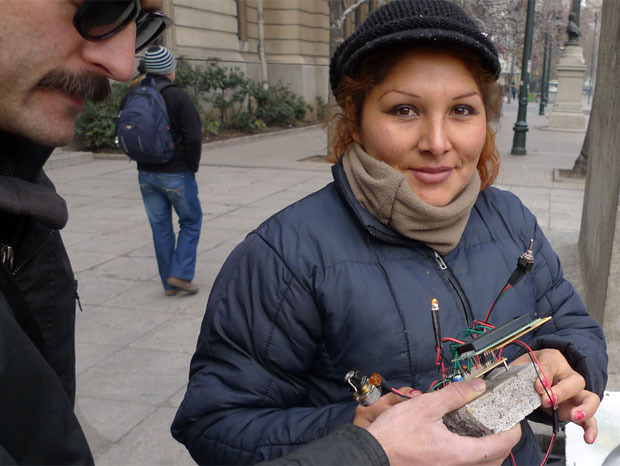
Pedestrians are questioned through a piece of sidewalk as electronic portable… What is the Miracle of Chile?
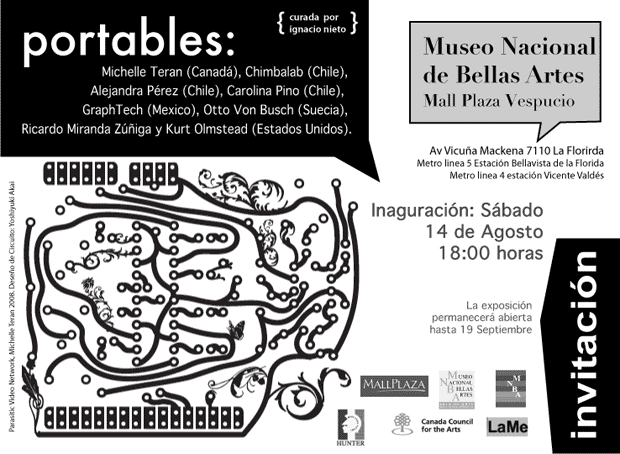
If in Santiago, check it out, if not, try the links in this entry…
Eight Hours in Lima
Kurt and I left San Francisco at 1:30am on July 26th, arrived in San Salvador around 7:30am and then borded a plane to Lima at 8:30am. We arrived in Lima in the early afternoon, perhaps 1pm and would not be catching our next flight until 10:30pm. So we headed for the downtown to check out the Museo del Convento de San Francisco and its catacombs. It was once the main graveyard of the city and you can still tour the catacombs and see the bones of city citizens buried below the church. As well as a great collection of paintings, an amazing library that is disintegrating and the architecture of the church itself.
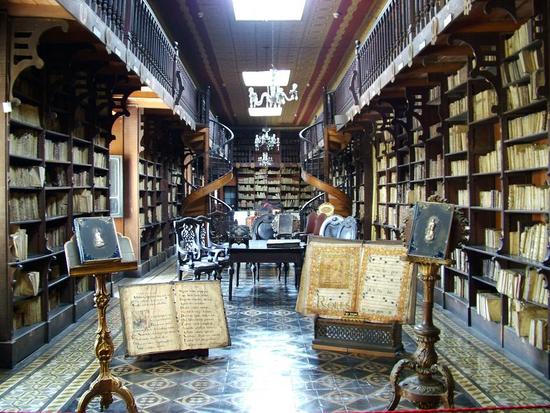
Photos were not allowed, so we took pictures outside and then toured the downtown.

We had excellent ham sandwiches at EL Cordano, an old bar and restaurant near the president’s house. That’s the cook, behind Kurt’s head cutting our ham.

Then we headed to the central square and the rest of downtown and I bought a great wool sweater and a nice shirt for a fraction of what it would have cost me in NYC
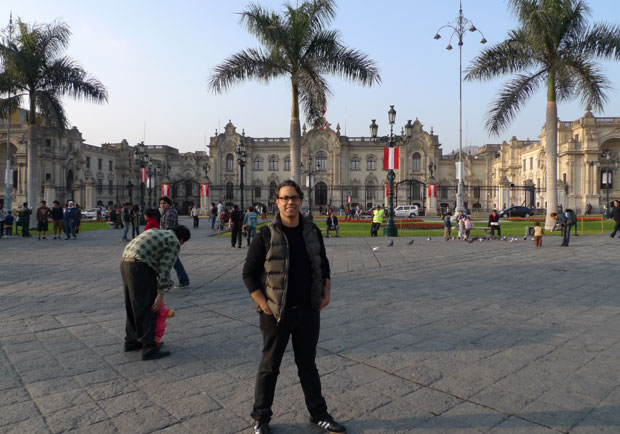
We hadn’t prepared for Lima and were surprised at the poverty of the capital. On the way in from the airport, many buildings appeared unfinished, abandoned or as if they had suffered a disaster. The general energy of the downtown was incredibly calm, which was surprising as they were about to celebrate their independence. The taxi drive back to the airport was one of the most horrific rides either of us had experienced, it was exhilarating and scary, Kurt tried to put his seatbelt on, but it didn’t work. I tried taking some photos, but it didn’t work:
